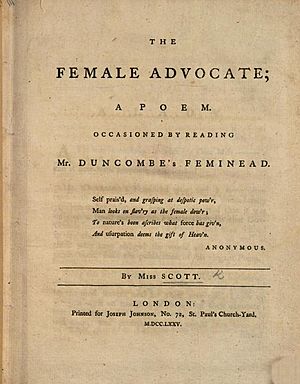The Female Advocate facts for kids

Title page of Mary Scott's The Female Advocate (1775)
|
|
| Author | Mary Scott |
|---|---|
| Subject | literary women |
| Genre | poetry |
| Published | London |
| Publisher | Joseph Johnson |
|
Publication date
|
1775 |
| Pages | viii+41 pp. |
Mary Scott's The Female Advocate (1775) is a special poem. It celebrates the amazing things women writers have done. It also strongly argues that women should have the right to express themselves through writing. The full title is The Female Advocate; a poem occasioned by reading Mr. Duncombe's Feminead.
Contents
About the Poem
Mary Scott's poem, The Female Advocate, was inspired by another poem. This was The Feminead: or, female genius. A poem (1754) by John Duncombe. Scott admired Duncombe's work. She wanted to add more "female geniuses" to his list. She also wanted to include women who became famous after he wrote his poem.
Duncombe's poem celebrated women writers from his time. Scott looked back even further in history. She wanted to show "what bright daughters BRITAIN once could boast." She wrote about women from the past two centuries. Many of her readers would have known these women already. She started with Catherine Parr, the learned sixth wife of Henry VIII.
Scott's poem combines two popular writing styles. One was the "catalogue of exemplary women," which Duncombe also used. This listed women who were great examples. The other style was the "defence of women." This type of writing argued for women's rights and abilities.
The poem has 522 lines. It is written in heroic couplets. This means every two lines rhyme and have a specific rhythm. Scott dedicated her poem to her close friend, Mary Steele. The poem also mentions other people from their group of friends.
Pen Names and Hidden Writers
In the 1700s, many writers used special names. These were called pen names or pseudonyms. They were like secret identities for authors. Scott used these names in her poem. For example, she used "Orinda" for Katherine Philips. She also used names that only her friends knew.
Sometimes, women writers published their work without using their real names. They wanted to stay anonymous. Scott included two anonymous writers in her poem. She also mentioned a third one in her introduction.
Amazing Women in The Female Advocate
Mary Scott's poem celebrates many talented women. She mentions some in her introduction and many more in the poem itself.
In the Introduction
In the introduction, Scott talks about four writers. They became famous after Duncombe wrote his poem. These include Hester Chapone, Hannah More, and Phillis Wheatley. She also mentions an unnamed author who published "poems by a lady." Scott believed there were many great women writers. She said, "Authors have appeared with honour, in almost every walk of literature."
In the Poem
Scott's poem lists many important women. Here are some of the notable figures she included:
- Catherine Parr (1512–1548): A queen and author of three books.
- Jane Grey (1537–1554): Known for her excellent education.
- Elizabeth Tudor (1533–1603): A queen who also wrote poetry.
- Margaret Cavendish (around 1624–1674): A philosopher, poet, scientist, and writer.
- Anne Killigrew (1660–1685): A talented poet and painter.
- Katherine Philips (1631/2–1664): A poet also featured in Duncombe's poem.
- Mary Chudleigh (1656–1710): A feminist poet and thinker.
- Constantia Grierson (around 1705–1732): An editor, poet, and expert in classical languages.
- Mary Barber (around 1685–1755): A poet.
- Mary Chandler (1687–1745): A poet.
- Mary Jones (1707–1778): A poet.
- Elizabeth Cooper (around 1698–1761): Scott praised her for collecting poetry from earlier times.
- Sarah Fielding (1710–1768): A novelist.
- Charlotte Lennox (around 1730–1804): A novelist, playwright, and poet.
- Elizabeth Griffith (1727–1793): A writer of plays, stories, and essays.
- Anne Steele (1717–1778): A hymn writer and essayist. She was a central figure in Scott's own writing group.
- Mary Whateley (1738–1825): A poet and playwright.
- Catharine Macaulay (1731–1791): A famous historian.
- Anna Williams (1706–1783): A poet.
- Elizabeth Montagu (1718–1800): A supporter of the arts, a literary critic, and a writer. She was part of the Blue Stockings Society.
- Anna Laetitia Barbauld (1743–1825): A poet, essayist, and author of children's books.
- John Duncombe (writer) (1729–1786): The author whose poem inspired Scott.
- Thomas Seward (1708–1790): Author of a work supporting women's right to literature.
- Anna Seward (1742–1809): A poet, mentioned by Scott as benefiting from Thomas Seward's ideas about educating girls.
See also
- Collective 18th-century biographies of literary women
- The Feminead
- The Unsex'd Females
Electronic text
- Full text at Scott, Mary. The Female Advocate; a poem occasioned by reading Mr. Duncombe's Feminead (London: Joseph Johnson, 1775). Google Books

